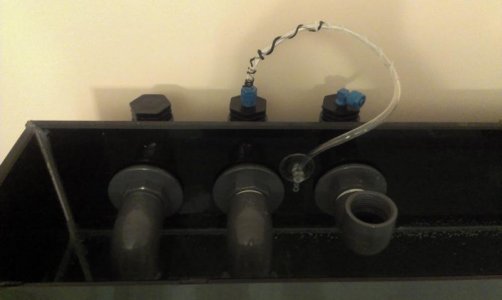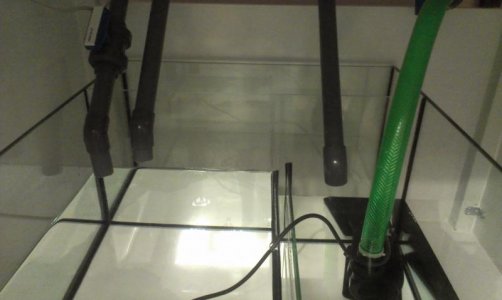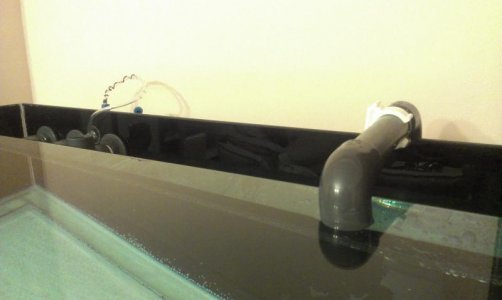Ok, I finally finished Beananimal coast to coast internal overflow system and yesterday started filling RO/DI water. Water passed through overflow and through siphon&openchannel standpipes, started to fill the sump. After water level passed the pump, wanted to give it a try to see how the system behaves. Return pump is Jebao dc-10000 so I decided to use it at lowest setting.
Short: Disaster.
Long:
First I must thell this is my first hands-on experience with a sump system below the tank, therefore be prepared to hear some stupid mistakes and second, the disaster is mainly not related to beananimal system.
Return pipe (all of the pipes are 1.25", btw) do not come to DT through holes but draws an U shape over the tank.
When I turn on the pump, everything was more or less ok, overflow filled and after a certain level, it started to drain. But, via openchannel and emergency pipes! The siphon was simply doing nothing. May worth to mention, siphon and openchannel pipes' sump ends were deeply submerged in water already even before running the pump. When I check with my hand, in the sump, openchannel was strongly pushing a good amount of water to sump (almost full capacity of pipe) and siphon was doing nothing other then releasing some air bubbles into overflow in every few seconds. So, obviously it was not functioning and heavy load was on shoulders of openchannel.
I was trying to understand why it happened this way and realised I completely forgot to put a tubing to the fitting which is waiting openly on top of openchannel. I asked my buddy to close the fitting by fingertip to see how the water level will react. While I was sitting in front of sump, he alerted me that water is rising and rising and my reaction was to turn off the pump. What a mistake! Return pipe's DT end was submerged also and as soon as I turn off the pump, reverse-siphon to the sump was started but It took a few valuable seconds for me to get whats going on. I blocked return pipe's tank end with my palm and at the same was trying to take it out of waterlevel (Thanks to Uncle and others who recommended return pipe runs over the tank, instead of drilling for the return hole, this way, it was not fixed and I was able to take it out of water after struggling for a short while, to break back-siphoning).
After collecting a bucket of water from ground, we moved return pipe out of water level, temporarily fixed there and decided to give it another try, this time, open channel air hole blocked from beginning and siphon and OC pipes' sump ends were kept out of water. Both siphon and OC pipes worked this time and water never reached to entrance of up-turned emergency elbow, but after a certain level in OFlow, it quickly drained with a lot of noise, then overflow refilled, then emptied again, a cycle with no end.
I can see its possibly related to the tubing over OC, but do not know at which level its end should be positioned at. Also, wondering how to prevent back-siphon, in case of electricity-failure or similar case, since I want to submerge the return pipe to tank to stop noise. I just put some soft tubing to OC (see pics below) but will change it tomorrow to something more robust. Meanwhile, I want to hear your opinions on my mistakes.
Regards,
Short: Disaster.
Long:
First I must thell this is my first hands-on experience with a sump system below the tank, therefore be prepared to hear some stupid mistakes and second, the disaster is mainly not related to beananimal system.
Return pipe (all of the pipes are 1.25", btw) do not come to DT through holes but draws an U shape over the tank.
When I turn on the pump, everything was more or less ok, overflow filled and after a certain level, it started to drain. But, via openchannel and emergency pipes! The siphon was simply doing nothing. May worth to mention, siphon and openchannel pipes' sump ends were deeply submerged in water already even before running the pump. When I check with my hand, in the sump, openchannel was strongly pushing a good amount of water to sump (almost full capacity of pipe) and siphon was doing nothing other then releasing some air bubbles into overflow in every few seconds. So, obviously it was not functioning and heavy load was on shoulders of openchannel.
I was trying to understand why it happened this way and realised I completely forgot to put a tubing to the fitting which is waiting openly on top of openchannel. I asked my buddy to close the fitting by fingertip to see how the water level will react. While I was sitting in front of sump, he alerted me that water is rising and rising and my reaction was to turn off the pump. What a mistake! Return pipe's DT end was submerged also and as soon as I turn off the pump, reverse-siphon to the sump was started but It took a few valuable seconds for me to get whats going on. I blocked return pipe's tank end with my palm and at the same was trying to take it out of waterlevel (Thanks to Uncle and others who recommended return pipe runs over the tank, instead of drilling for the return hole, this way, it was not fixed and I was able to take it out of water after struggling for a short while, to break back-siphoning).
After collecting a bucket of water from ground, we moved return pipe out of water level, temporarily fixed there and decided to give it another try, this time, open channel air hole blocked from beginning and siphon and OC pipes' sump ends were kept out of water. Both siphon and OC pipes worked this time and water never reached to entrance of up-turned emergency elbow, but after a certain level in OFlow, it quickly drained with a lot of noise, then overflow refilled, then emptied again, a cycle with no end.
I can see its possibly related to the tubing over OC, but do not know at which level its end should be positioned at. Also, wondering how to prevent back-siphon, in case of electricity-failure or similar case, since I want to submerge the return pipe to tank to stop noise. I just put some soft tubing to OC (see pics below) but will change it tomorrow to something more robust. Meanwhile, I want to hear your opinions on my mistakes.
Regards,



